|
|
|
Sort Order |
|
|
|
Items / Page
|
|
|
|
|
|
|
| Srl | Item |
| 1 |
ID:
192303
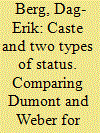

|
|
|
|
|
| Summary/Abstract |
In this article I argue that the concept of status requires more attention in today’s scholarly approach to caste. Caste has become a contested concept which authors define in multiple ways, but the different definitions of status in India’s caste system remain unclear. This article focusses on the two seminal contributions of Louis Dumont and Max Weber. Both have frequently been criticised and dismissed, but this article aims to delineate and compare their different understandings of status. Their contributions have often been judged according to their cultural significance or general concepts of modernity; however, by unpacking their approaches to status, a proper distinction can be made between achieved and attributed status in the study of caste. Thus, revisiting and comparing Dumont’s and Weber’s different concepts of status may create greater clarity when explaining ‘exclusion’ and the evolving caste practices in India and in the diaspora.
|
|
|
|
|
|
|
|
|
|
|
|
|
|
|
|
| 2 |
ID:
192300


|
|
|
|
|
| Summary/Abstract |
Building on anthropological developments in the study of the state that highlight its margins, informal connections, and everyday dynamics, this paper examines the diverse strategies that Tanchangya villagers employ while negotiating peace and ‘development’ processes with local state actors in the Chittagong Hill Tracts (CHT), Bangladesh. It shows that the state is manifested in various forms at the local level. In a myriad of forms of encounters with state actors, Tanchangya villagers employ situated strategies of avoidance, engagement, and resistance. The paper claims that these strategies ultimately contribute to challenge the dominant processes that confine Tanchangya villagers to a state of marginalisation, and aim to aid in the struggle to create greater spaces for the social, economic, and political dimensions of their lives. Thus, this paper offers an analysis of micro-power struggles that take place in the CHT’s rural spaces vis-à-vis the complex matrix of peace, citizenship, and ‘development’ in the region.
|
|
|
|
|
|
|
|
|
|
|
|
|
|
|
|
| 3 |
ID:
192306
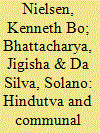

|
|
|
|
|
| Summary/Abstract |
In this viewpoint article, we analyse the heated controversy that unfolded in 2022 over who should be considered Goa’s patron saint: St. Francis Xavier or Bhagwan Parshuram. The controversy was sparked by a Hindu right organization named Hindu Raksha Maha Aghadi and its release of what it – with allusions to Vivek Agnihotri’s blockbuster ‘The Kashmir files’ – presented as ‘the Goa files’. These files ostensibly sought to bring to light the forced conversion of Goans to Catholicism under colonial rule, alongside other atrocities committed by Portuguese colonialists during their 450 years of rule in Goa. Taking our point of departure in an analysis of the contemporary symbolisms and political uses of Lord Parshuram both within and beyond Goa, coupled with an examination of the activities of Hindu nationalist groups in the state, we show how the campaign centred on Lord Parshuram and the ‘Goa Files’ were intended to produce communal polarization and further the Hindutva agenda in Goa. In this regard, political developments in India’s smallest state mirror broader national trends where the line between the mainstream Hindu nationalism of the BJP and the more radical ‘fringe groups’ is becoming increasingly blurred.
|
|
|
|
|
|
|
|
|
|
|
|
|
|
|
|
| 4 |
ID:
192302
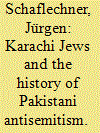

|
|
|
|
|
| Summary/Abstract |
With the help of multi-sited ethnography in Israel and Pakistan, this paper looks at the history of antisemitism in the Islamic Republic of Pakistan. I show that while antisemitism is widespread in parts of Pakistani society today, it was not the reason why most of Karachi’s Jews left the country in the 1960s or the 1970s. In the paper, I explore possible explanations for the rise of antisemitism in parts of Pakistan’s society.
|
|
|
|
|
|
|
|
|
|
|
|
|
|
|
|
| 5 |
ID:
192298


|
|
|
|
|
| Summary/Abstract |
This paper is an ethnographic account of elite neighbourhoods in Delhi. It unpacks the lived realities of these neighbourhoods by studying how elite-ness is both constituted and contested within gated residential areas and other public spaces of Delhi. It argues that elites extend the unequal world they inhabit outside their gated residences by identifying certain public spaces for their leisure activities, especially shopping malls, leaving the neighbourhood community centres or RWA clubs to cater to non-elite residents. It also focuses on the narratives of the domestic staff employed in elite households, who too inhabit the public spaces within these neighbourhoods, including parks, streets, and markets. In this way, the paper draws out the class contestations within elite neighbourhoods and explains how these spaces become sites of class fractions and factions as they are marked by the politics of who a ‘real’ elite is. As such, this paper is an account of how class exclusionary boundaries are drawn and subverted by elites and non-elites both in private (gated neighbourhoods) and public spaces (parks, shopping malls), thus bringing attention to the fractured realities of elite neighbourhoods.
|
|
|
|
|
|
|
|
|
|
|
|
|
|
|
|
| 6 |
ID:
192297


|
|
|
|
|
| Summary/Abstract |
This article focuses on a relatively overlooked dimension of urban development in India: the nature of community-making in new urban spaces. Using concepts from sociological and geographical literature on community formation, it examines the relationship between specific forms of urbanisation in contemporary (neo-liberal) India and community-making processes. The study is situated in the city of Noida within the national capital region in northern India. Examining two habitational forms, that of urban middle-class enclaves and urban villages, we suggest that a model of urbanisation involving eminent domain (the state’s power to acquire private property and convert it into public use) to produce gentrified urban spaces may promote conditions for rival forms of exclusivist community-making, including nativist ‘othering’.
|
|
|
|
|
|
|
|
|
|
|
|
|
|
|
|
| 7 |
ID:
192304
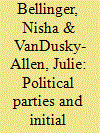

|
|
|
|
|
| Summary/Abstract |
In this analysis, we examine the relationship between the effective number of parliamentary parties (ENPP) at the state level in India and the initial policy responses among Indian state governments to the COVID-19 pandemic between January and April 2020. We find that by April 2020, Indian states with a relatively lower ENPP adopted more stringent measures to address the spread of the pandemic while states with a higher ENPP adopted less stringent measures. We hypothesize that it may have been more difficult for states with a larger number of parties to quickly adopt mitigation measures early in the pandemic, while it may have been relatively easier for states with a smaller number of parties. We discuss avenues for future research given the findings and the data presented in the paper.
|
|
|
|
|
|
|
|
|
|
|
|
|
|
|
|
| 8 |
ID:
192305
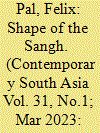

|
|
|
|
|
| Summary/Abstract |
The Indian Hindu nationalist movement is largely sustained by a network, hundreds of organisations strong, linked in greater or lesser degrees to a central organisational node: the Rashtriya Swayamsevak Sangh. In this paper I propose a new, critical, definition of this network: That which is constituted by organisational sites through which a central executive may exert authority, (a) through existing institutionalised communication channels, and (b) without coercion. By reconfiguring the analytic focus on this network, which I refer to as the Sangh, from its organisational nodes, to the linkages through which power travels, I propose a new research agenda on this Hindu nationalist organisational network that I argue more clearly identifies the spread, intentions and weaknesses of the far-right in India.
|
|
|
|
|
|
|
|
|
|
|
|
|
|
|
|
| 9 |
ID:
192296
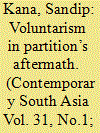

|
|
|
|
|
| Summary/Abstract |
This article adopts an alternative framework for thinking about the Nehruvian state and the drivers that shaped India’s postcolonial development strategy. This is a firm shift away from viewing development as a technocratic enterprise, and towards a focus on how the Nehruvian state sought to deploy notions of voluntarism. Within the Indian context, voluntarism referred to the mobilisation of ordinary people to further local development projects. This article investigates voluntarism through efforts at rehabilitating able-bodied refugees in Faridabad. Like many refugee townships that were constructed in the immediate aftermath of Partition, Faridabad was built from the ground up entirely through reskilled able-bodied refugee labour. Within the environment of rehabilitation, the article shows how voluntarism through the cooperative model became an integral postcolonial development strategy adopted by the Nehruvian state to construct new distinct urban spaces on formerly uncultivated lands. However, the article will reveal how the Nehruvian state’s use of voluntarism was beset with tensions, challenges, and problems. The article shows how widespread refugee discontent, bureaucratic mismanagement and alleged financial misconduct ultimately impeded the Nehruvian vision of empowering and mobilising ordinary Indians to further projects of public utility.
|
|
|
|
|
|
|
|
|
|
|
|
|
|
|
|
| 10 |
ID:
192301


|
|
|
|
|
| Summary/Abstract |
Development scholars have noticed the decoupling of rural poverty and well-being from agriculture and other traditional livelihoods, and the greater importance of highly mobile and delocalized livelihoods across the Global South. In this context, the Indian Himalayan state of Himachal Pradesh has been hailed as a development exemplar. While there is undeniable though uneven economic mobility across the state, what of its spatiotemporality? As more capital makes its way to interior regions, where and how is it fixed, and how do these processes reconfigure prevalent rhythms of life? This paper considers the changing materiality of the urbanizing settlement of Bharmour, the centre of the agri-pastoralist Gaddi community in Himachal, alongside the intersecting temporalities experienced by its residents. The pastoralist seasonal time has historically structured the rhythms of the region. Since the late colonial period, but with greater intensity since the 1970s, the state has sought to discipline time through the broader discourse of tribal development. More recently, state-backed capitalism aims to flatten time towards the accelerated circulation of people, information, and commodities. Theorizing spatiotemporality from the perspective of Bharmour shows that despite these changes, pastoralist rhythms continue to shape the settlement, producing a form of the urban the paper terms ‘the seasonal town’.
|
|
|
|
|
|
|
|
|
|
|
|
|
|
|
|
| 11 |
ID:
192299
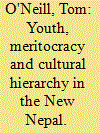

|
|
|
|
|
| Summary/Abstract |
This paper explores Nepali youth expectations about political equality in the ‘New’ Nepal following the promulgation of a constitution in 2015. It discusses the outcome of seven deliberative youth assemblies held across the country in 2018 and 2019, in which youth debated their priorities for the governments at the local, provincial, and federal levels. These assemblies revealed that youth were committed to a conception of meritocracy that prioritizes individual achievement over cultural ascription as a basis for social and economic justice. Current efforts to introduce equity through ethnic, caste, and gender reservations were seen as useful instruments to achieve this equality but also distrusted as they appeared to contradict meritocratic principles or as tactics to sustain Nepal’s existing cultural barriers.
|
|
|
|
|
|
|
|
|
|
|
|
|
|
|
|
|
|
|
|
|